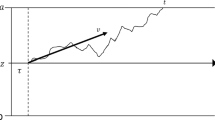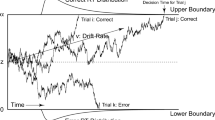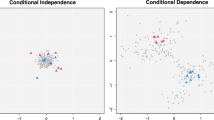Abstract
On the basis of a combination of linear ballistic accumulation (LBA) and item response theory (IRT), this paper proposes a new class of item response models, namely LBA IRT, which incorporates the observed response time (RT) by means of LBA. Our main objective is to develop a simple yet effective alternative to the diffusion IRT model, which is one of best-known RT-incorporating IRT models that explicitly models the underlying psychological process of the elicited item response. Through a simulation study, we show that the proposed model enables us to obtain the corresponding parameter estimates compared with the diffusion IRT model while achieving a much faster convergence speed. Furthermore, the application of the proposed model to real personality measurement data indicates that it fits the data better than the diffusion IRT model in terms of its predictive performance. Thus, the proposed model exhibits good performance and promising modeling capabilities in terms of capturing the cognitive and psychometric processes underlying the observed data.













Similar content being viewed by others
References
Annis, J., Miller, B. J., & Palmeri, T. J. (2016). Bayesian inference with Stan: A tutorial on adding custom distributions. Behavior Research Methods, 48, 1–24.
Box, G. E. P. (1979). Robustness in the strategy of scientific model building. In R. L. Launer & G. B. Wilkinson (Eds.), Robustness in statistics (pp. 201–236). New York: Academic Press.
Brown, A., & Maydeu-Olivares, A. (2011). Item response modeling of forced choice questionnaires. Educational and Psychological Measurement, 71, 460–502.
Brown, S. D., & Heathcote, A. (2008). The simplest complete model of choice response time: Linear ballistic accumulation. Cognitive Psychology, 57, 153–178.
Condon, D. M., & Revelle, W. (2015). Selected personality data from the SAPA-Project: On the structure of phrased self-report items. Journal of Open Psychology Data, 3, e6.
Deuter, M., Bradbery, J., & Turnbull, J. (2015). Oxford advanced learner’s dictionary (9th ed.). London: Oxford University Press.
Donkin, C., Brown, S., Heathcore, A., & Wagenmakers, E. J. (2011). Diffusion versus linear ballistic accumulation: Different models but the same conclusions about psychological processes? Psychonomic Bulletin & Review, 18, 61–69.
Feller, W. (1968). Random walk and ruin problems. In W. Feller (Ed.), An introduction to probability theory and its applications (3rd ed., Vol. 1, pp. 342–371). New York: Wiley.
Ferrando, P. J. (2007). A Pearson-type-VII item response model for assessing person fluctuation. Psychometrika, 72, 25–41.
Ferrando, P. J., & Lorenzo-Seva, U. (2007). An item response theory model for incorporating response time data in binary personality items. Applied Psychological Measurement, 31, 525–543.
Gelman, A., Carlin, J. B., Stern, H. S., Dunson, D. B., Vehtari, A., & Rubin, D. B. (2014). Bayesian data analysis (3rd ed.). New York: CRC Press.
Gelman, A., Jakulin, A., Pittau, M. G., & Su, Y. S. (2008). A weakly informative default prior distribution for logistic and other regression models. Annals of Applied Statistics, 2, 1360–1383.
Grice, G. R. (1968). Stimulus intensity and response evocation. Psychological Review, 75, 359–373.
Heathcote, A., Brown, S. D., & Wagenmakers, E.-J. (2015). An introduction to good practices in cognitive modeling. In B. U. Forstmann & E.-J. Wagenmakers (Eds.), An introduction to model-based cognitive neuroscience. Berlin: Springer Science & Business Media.
Heathcote, A., & Hayes, B. (2012). Diffusion versus linear ballistic accumulation: Different models for response time with different conclusions about psychological mechanisms? Canadian Journal of Experimental Psychology, 66, 125–136.
Heathcote, A., & Love, J. (2012). Linear deterministic accumulator models of simple choice. Frontiers in Psychology, 3, 292.
Kuncel, R. B. (1973). Response process and relative location of subject and item. Educational and Psychological Measurement, 33, 545–563.
Laming, D. R. J. (1968). Information theory of choice reaction time. New York: Wiley.
Leite, F. P., & Ratcliff, R. (2011). What cognitive process drive response biases? A diffusion model analysis. Judgment and Decision Making, 6, 651–687.
Luce, R. D. (1986). Response times. New York: Oxford University Press.
Molenaar, D., Tuerlinckx, F., & van der Maas, H. L. J. (2015). Fitting diffusion item response theory models for responses and response times using the R package diffIRT. Journal of Statistical Software, 66, 1–34.
Neyman, J., & Scott, E. L. (1948). Consistent estimates based on partially consistent observations. Econometrica, 16, 1–32.
Okada, K., Vandekerckhove, J., & Lee, M. D. (2018). Modeling when people quit: Bayesian censored geometric models with hierarchical and latent-mixture extensions. Behavior Research Methods, 50, 406–415.
Palada, H., Neal, A., Vuckovic, A., Martin, R., Samuels, K., & Heathcote, A. (2016). Evidence accumulation in a complex task: Making choices about concurrent multiattribute stimuli under time pressure. Journal of Experimental Psychology: Applied, 22, 1–23.
Ratcliff, R. (1978). A theory of memory retrieval. Psychological Review, 85, 59–108.
Ratcliff, R., Thapar, A., & Mckoon, G. (2007). Application of the diffusion model to two-choice tasks for adults 75–90 years old. Psychology and Aging, 22, 56–66.
Reddi, B. A. J., & Carpenter, R. H. (2000). The influence of decision time on performance. Nature Neuroscience, 3, 827–830.
Roscam, E. E. (1987). Toward a psychometric theory of intelligence. In E. E. Roscam & R. Suck (Eds.), Progress in mathematical psychology (pp. 151–174). Amsterdam: North-Holland.
Roscam, E. E. (1997). Models for speed and time-limit tests. In W. J. van der Linden & R. K. Hambleton (Eds.), Handbook of modern item response theory (pp. 187–208). Berlin: Springer Science & Business Media.
Stone, M. (1960). Models for choice-reaction time. Psychometrika, 25, 251–260.
Thissen, D. (1983). Timed testing: An approach using item response theory. In D. J. Weiss (Ed.), New horizons in testing: Latent trait test theory and computerized adapting testing (pp. 179–203). New York: Academic Press.
Tuerlinckx, F., & De Boeck, P. (2005). Two interpretations of the discrimination parameter. Psychometrika, 70, 629–650.
Tuerlinckx, F., Molenaar, D., & van der Maas, H. L. J. (2016). Diffusion-based response-time models. In W. J. van der Linden & R. K. Hambleton (Eds.), Handbook of item response theory, volume one: Models (pp. 283–300). Boca Raton: Chapman & Hall/CRC Press.
van der Linden, W. J. (2016). Lognormal response-time model. In W. J. van der Linden (Ed.), Handbook of item response theory, volume one: Models (pp. 261–282). Boca Raton: Chapman & Hall/CRC Press.
van der Maas, H. L. J., Molenaar, D., Maris, G., Kievit, R. A., & Borsboom, D. (2011). Cognitive psychology meets psychometric theory: On the relation between process models for decision making and latent variable models for individual differences. Psychological Review, 118, 339–356.
van der Maas, H. L. J., & Wagenmakers, E.-J. (2005). A psychometric analysis of chess expertise. The American Journal of Psychology, 118, 29–60.
van Ravenzwaaij, D., & Oberauer, K. (2009). How to use the diffusion model: Parameter recovery of three methods: EZ, fast-dm, and DMAT. Journal of Mathematical Psychology, 53, 463–473.
Vehtari, A., Gelman, A., & Gabry, J. (2017). Practical Bayesian model evaluation using leave-one-out cross-validation and WAIC. Statistics and Computing, 27, 1413–1432.
Voss, A., Nagler, M., & Lerche, V. (2013). Diffusion models in experimental psychology: A practical introduction. Experimental Psychology, 60, 385–402.
Wagenmakers, E.-J., van der Maas, H. L. J., & Grasman, R. P. P. P. (2007). An EZ-diffusion model for response time and accuracy. Psychonomic Bulletin & Review, 14, 3–22.
Watanabe, S. (2010). Asymptotic equivalence of Bayes cross validation and widely applicable information criterion in singular learning theory. Journal of Machine Learning Research, 11, 3571–3594.
Watanabe, S. (2013). A widely applicable Bayesian information criterion. Journal of Machine Learning Research, 14, 867–897.
Funding
Funding was provided by Japan Society for the Promotion of Science (Grant nos. JP17J07674, JP17H04787) and Okawa Foundation Research Grant.
Author information
Authors and Affiliations
Corresponding author
Additional information
Publisher's Note
Springer Nature remains neutral with regard to jurisdictional claims in published maps and institutional affiliations.
The R and Stan codes used in this study can be found at https://osf.io/ck7fr/.
Rights and permissions
About this article
Cite this article
Bunji, K., Okada, K. Item response and response time model for personality assessment via linear ballistic accumulation. Jpn J Stat Data Sci 2, 263–297 (2019). https://doi.org/10.1007/s42081-019-00040-4
Received:
Accepted:
Published:
Issue Date:
DOI: https://doi.org/10.1007/s42081-019-00040-4




